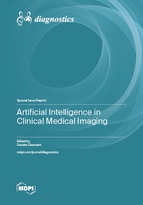Artificial Intelligence in Clinical Medical Imaging
A special issue of Diagnostics (ISSN 2075-4418). This special issue belongs to the section "Machine Learning and Artificial Intelligence in Diagnostics".
Deadline for manuscript submissions: closed (30 November 2023) | Viewed by 16543
Special Issue Editor
Interests: biomedical engineering; robotics; artificial intelligence; digital health; rehabilitation; smart technology; cybersecurity; mental health; animal-assisted therapy; social robotics; acceptance; diagnostic pathology and radiology; medical imaging; patient safety; healthcare quality; health assessment; chronic disease
Special Issues, Collections and Topics in MDPI journals
Special Issue Information
Dear Colleagues,
We are delighted to invite you to submit your latest research work to the Special Issue "Artificial Intelligence in Clinical Medical Imaging". As a guest editor, I am excited to lead this Special Issue and to provide a platform for the dissemination of cutting-edge research on the integration of AI into clinical medical imaging. The field of medical imaging has seen remarkable advancements in recent years, particularly with the introduction of artificial intelligence (AI) techniques. AI has the potential to revolutionize clinical medical imaging by enabling more accurate, efficient, and personalized diagnoses and treatments. The Special Issue covers a range of topics related to AI in medical imaging, including, (but not limited to):
- Deep learning techniques for medical image analysis;
- Image segmentation and feature extraction;
- Computer-aided diagnosis and detection of diseases;
- Disease progression prediction using imaging data;
- Image registration and fusion for multimodal imaging;
- Clinical decision support systems for medical imaging;
- Image-based treatment planning and evaluation;
- Data privacy and security in AI for medical imaging;
- Standardization of imaging protocols for AI applications;
- Ethical and social implications of AI in medical imaging.
We welcome original research articles, reviews, and case studies that cover any of these topics. Our goal is to provide a comprehensive overview of the current state of AI in clinical medical imaging and its potential to transform healthcare. We hope that authors could make a significant contribution to this Special Issue. We are confident that this Special Issue will be a valuable resource for researchers and practitioners working in the field of medical imaging.
Feel free to contact us if you have any questions.
Dr. Daniele Giansanti
Guest Editor
Manuscript Submission Information
Manuscripts should be submitted online at www.mdpi.com by registering and logging in to this website. Once you are registered, click here to go to the submission form. Manuscripts can be submitted until the deadline. All submissions that pass pre-check are peer-reviewed. Accepted papers will be published continuously in the journal (as soon as accepted) and will be listed together on the special issue website. Research articles, review articles as well as short communications are invited. For planned papers, a title and short abstract (about 100 words) can be sent to the Editorial Office for announcement on this website.
Submitted manuscripts should not have been published previously, nor be under consideration for publication elsewhere (except conference proceedings papers). All manuscripts are thoroughly refereed through a single-blind peer-review process. A guide for authors and other relevant information for submission of manuscripts is available on the Instructions for Authors page. Diagnostics is an international peer-reviewed open access semimonthly journal published by MDPI.
Please visit the Instructions for Authors page before submitting a manuscript. The Article Processing Charge (APC) for publication in this open access journal is 2600 CHF (Swiss Francs). Submitted papers should be well formatted and use good English. Authors may use MDPI's English editing service prior to publication or during author revisions.
Keywords
- diagnostics
- medical imaging
- artificial intelligence
- medical decision
- clinical medical imaging







